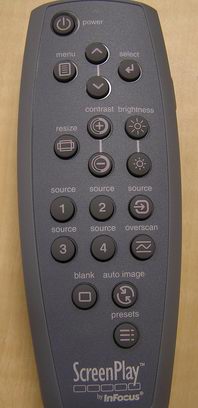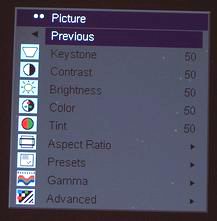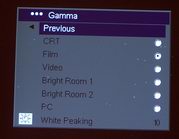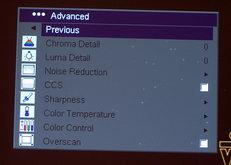Choosing a screen
The InFocus Screenplay 4805 projector has the lumens to handle a 100" in a typical dark room (larger screens too, especially if your walls are dark). For testing/viewing purposes, the projector was normally in its full power mode, and the projector was viewed at either 98" diagonal on a matte white Stewart screen, or my 128" Stewart Firehawk (high contrast "white" screen). I found my big screen to be too much for the InFocus projector, so reduced the image size and viewed at approximately 110" diagonal, where the InFocus had sufficient power.
Since you loose about 20% of brightness in economy mode, but significantly improve lamp life, here's how I see screen selection:
If you are on a budget and want to maximize lamp life (use economy mode), and your screen is less than 100" diagonal, I would recommend a high contrast gray surface, such as the Da-Lite HC Da-Mat (or Stewart Grayhawk) surface. If you go with 100" diagonal, either crank up the power, or switch to a High Contrast white such as the Da-Lite HC Cinema Vision surface, or Stewart Firehawk.)
For 110" or larger (I wouldn't recommend going larger) screens, definitely avoid the darker gray surfaces, you will run out of brightness. In fact I would recommend a screen with positive gain. (greater than 1.) The Cinema Vision surface mentioned has a gain of 1.1 and the Firehawk, 1.3. That basically translates to 10 and 30% brighter than a 1.0 gain matte surface. Note: the size of your room, and color of your walls will affect recommendations. Ideally you want a near dark room with dark walls (ala movie theater!), if your walls are off white, you will lose some contrast and the image will not appear as bright, so adjust your choices accordingly. The smart money is to work with a knowledgeable sales consultant, who should ask you about your room lighting, wall color, etc., before recommending a surface based on the screen size you desire.
Noise levels
The Screenplay 4805 projector could be a lot quieter. It is significantl noiser than newer home theater projectors, and if you are running it in full power mode, you will almost certainly notice it on relatively quiet moments while viewing movies or tv.
The good news is that in economy mode it is pretty quiet, although it actually is a little noisier than most newer home theater projectors set for full power. Still, in economy mode it should not be noticeable most of the time, even on those relatively quiet scenes.
The point here, is that the relatively loud noise level is one of the biggest weaknesses for this projector. There are those who simply will not find it acceptable, especially with plenty of quieter projectors to choose from.
Remote Control
The InFocus remote is pretty typical, and is easy to use. The remote buttons are backlit with a button on the side, to engage the light. The remote has separate buttons for brightness and contrast (both have up and down buttons) source buttons for switching, an auto setup, and of course menu and navigation arrows. There is also a button at the bottom for presets, and one for blanking the screen.
 Click Image to Enlarge
Click Image to EnlargeMenus
These could use work. Of course picture quality is what this is all about, but the InFocus menus, while pretty well organized, are a bit dark and hard to read. Here are shots of the major menus.
The InFocus has no problems with light leakage.
InFocus Screenplay 4805 - Menu
InFocus Screenplay 4805 - Menu
Lens shift
Sorry, no lens shift, which is expected. I am not aware of any DLP home theater projectors currently selling for under $2500 that offer variable lens shift. For those not familiar, lens shift allows you to keep the image rectangular from different mounting or table angles to the screen, without using keystone correction (which is destructive - degrading the image). Typically to find a projector with lens shift, you are looking at LCD projectors selling for around $1600 - $2000+, or DLP projectors starting at $3000. Without lens shift, it is important to correctly position the projector vertically relative to the screen.






